
Compara o investimento extensivo e o impacto no valor comercial de uma integração do tipo faça você mesmo com as eficiências e o valor fornecido usando o eiPaaS da Digibee.

Compara o investimento extensivo e o impacto no valor comercial de uma integração do tipo faça você mesmo com as eficiências e o valor fornecido usando o eiPaaS da Digibee.

Seus sonhos de cifrões estão se transformando em pesadelos enquanto você observa seus complicados projetos de integração de TI se arrastarem por meses (ou o que parecem anos)?
Você pode ter pensado inicialmente que uma solução de integração tradicional seria a solução mágica que resolveria todos os seus problemas de TI, mas agora você está percebendo que pode ter errado o alvo ao fazer parceria com um único provedor de integração.
As soluções de integração tradicionais podem parecer fazer mais sentido, especialmente se você já tiver uma parceria, mas à medida que o tempo e o orçamento diminuem, pode ser hora de considerar outras opções. Se você decidir olhar em outra direção, não estará sozinho. Muitos clientes já relatou estar insatisfeito com o complexo esquema de preços das soluções de integração tradicionais.
Esses tipos de sistemas de integração podem ter outras desvantagens dispendiosas que você talvez não tenha considerado, como:
Mesmo que você já tenha investido em uma solução tradicional, ainda poderá reduzir seus custos contínuos de integração e resolver muitas das deficiências de sua integração atual com a ajuda da Digibee. Veja como.
>> Agende uma demonstração personalizada com nossa equipe de especialistas e veja como o iPaaS da Digibee trará eficiência ao seu negócio.
Com o Digibee, você não precisa se preocupar com riscos de entrega e altos custos iniciais de integração. A maneira simples de começar do Digibee reduz os riscos de entrega e o custo total de propriedade para sua integração de TI.
Primeiro: eles constroem, você observa. Os membros do Digibee Integration Squad começam e fazem todo o trabalho, e você não precisa levantar um dedo. A única coisa que você precisa fazer neste estágio é compartilhar o fluxo de dados e ajudar o Digibee a se conectar às fontes de dados. É isso. Sem risco, sem custo.
Próximo: Você toma a decisão final. Depois que o Digibee concluir a integração corporativa com a ajuda de sua equipe, você poderá escolher se deseja ou não avançar com a implantação para produção e a assinatura. É uma decisão de baixo risco em que você tem controle total sobre o sucesso e o resultado do projeto. Se você optar por seguir em frente, a integração corporativa será implantada na produção e a assinatura será iniciada. Se recusar, a assinatura é cancelada, sem pagamento e sem risco de aquisição para sua empresa.
Nem todas as soluções de integração corporativa são criadas iguais. De acordo com o jornal Digibee, 5 (+1) razões para escolher uma solução de integração moderna, O inovador eiPaaS da Digibee oferece alguns benefícios que os provedores tradicionais simplesmente não conseguem igualar. Mesmo a Forrester afirma que o Digibee fornece um impacto financeiro positivo significativo em um período de tempo relativamente curto, no relatório Forrester, The Total Economic Impact™ da plataforma de integração empresarial como serviço (iPaaS) da Digibee.
O Digibee tem preços e benefícios competitivos quando comparado a todos os tipos de soluções de integração, mas o Digibee realmente se destaca quando se trata de preço de plataforma como serviço de integração (preço iPaaS) com simplicidade de assinatura, tempo mais rápido para valor, e custo total de propriedade.
Provedores de integração mais estabelecidos têm modelos de preços complexos que geralmente têm cobranças extras ocultas para treinamento, certificação de desenvolvedor, suporte, manutenção ou conexões adicionais. Com o modelo transparente de preços da Digibee, não há surpresas inesperadas ou taxas ocultas.
O software intuitivo e pronto para uso do Digibee low-code plataforma reduz seu tempo de lançamento no mercado em 70%, para que você possa concluir projetos de integração em semanas, em vez de meses ou anos. Pense na redução de custos de TI se você puder criar integrações até 10 vezes mais rápidas usando o Digibee’s low code plataforma.
Em média, o custo geral do preço iPaaS da Digibee é quase 50% menor do que outras soluções de integração, e a Digibee inclui até cinco vezes mais produção pipelines em comparação com outros provedores.
A implementação da plataforma de integração empresarial como um serviço (eiPaaS) da Digibee pode fornecer benefícios financeiros significativos para sua empresa – mas você não precisa acreditar em nossa palavra – veja apenas alguns dos resultados que os clientes estão obtendo com as soluções da Digibee. relatório de Digibee afirma que, por meio de entrevistas com clientes e agregação de dados, a Forrester concluiu que o eiPaaS da Digibee tem o seguinte impacto financeiro em três anos.
$2.4M
$1.2M
US$902K
$1.3M
Economia para uma empresa hipotética com 20,000 funcionários, 6 desenvolvedores e receita anual de US$ 5 bilhões
Fonte: 5 (+1) razões para escolher uma solução de integração moderna, Digibee, 2023
Muitos clientes estão percebendo rapidamente o ROI da plataforma e outros benefícios financeiros de trabalhar com a Digibee. “O Digibee não apenas nos ajuda a reduzir custos, mas também nos permite trazer mais clientes e mais receita para a empresa”, disse um gerente sênior de habilitação de nuvem em uma empresa de telecomunicações que obteve resultados significativos.
| Valor presente líquido | ROI | Período de retorno |
|---|---|---|
| $4.15M | 232% | <6 months |
Fonte: 5 (+1) razões para escolher uma solução de integração moderna, Digibee, 2023
Leia o recurso Digibee, 5 (+1) razões para escolher uma solução de integração moderna para saber mais sobre como economizar tempo e dinheiro em sua integração de TI. Descubra todos os benefícios da moderna plataforma de integração em nuvem da Digibee, incluindo comparações detalhadas entre os modelos de integração tradicionais e a solução empresarial iPaaS da Digibee. Faça uma análise de economia de custos para o seu negócio e experimente você mesmo para experimentar a diferença do Digibee.
Para mais informações, leia Histórias de sucesso de clientes da Digibeeou entre em contato com a Digibee para agendar uma demonstração.

Discussão com Johnny Russo, Chief Digital Officer da Lamour sobre transformação digital e liderança consciente.

Seus desenvolvedores profissionais estão gastando todo o seu tempo escrevendo códigos tediosos para integrações internas de TI? Ou talvez eles estejam gastando centenas de horas em treinamento e certificação para soluções tradicionais de plataforma como serviço de integração corporativa (iPaaS corporativo), quando poderiam estar gastando seu tempo dispendioso em atividades mais valiosas para a empresa.
Ao contemplar sua estratégia de integração empresarial, você precisa considerar todos os fatores envolvidos. Eles podem incluir as habilidades técnicas de sua equipe atual, seus recursos disponíveis, o impacto econômico total do projeto e o retorno sobre o investimento (ROI da plataforma) e quanto tempo você pode dedicar ao projeto de integração de TI – em cada estágio do processo de ‘construir, executar, monitorar’.
Ao desenvolver sua estratégia de integração, um dos primeiros passos é determinar que tipo de solução de integração de TI é melhor para sua empresa.
>> Agende uma demonstração personalizada com nossa equipe de especialistas e veja como o iPaaS da Digibee trará eficiência ao seu negócio.
Antes de tomar grandes decisões sobre sua estratégia de integração de TI, você deve reconhecer o prioridades concorrentes de integrações de TIe compreender os diferentes tipos de integrações e seu código pró versus low-code .
Existem geralmente três tipos de soluções de integração; cada um com diferentes requisitos de codificação:
Vamos analisar cada tipo em detalhes para descobrir a melhor escolha para sua empresa.
Muitas empresas adotam como padrão a construção e manutenção de suas próprias soluções de integração de TI com codificadores profissionais internos (pro-code). Eles podem ter desenvolvedores e engenheiros de software internos que se orgulham de criar soluções de TI desenvolvidas internamente e geralmente estão ansiosos para enfrentar um grande projeto, como uma implementação de integração multifacetada.
No entanto, de acordo com o relatório da Digibee, ‘Como decidir sobre uma estratégia de integração‘, esse tipo de abordagem tradicional interna/doméstica pode criar alguns riscos e desafios sérios:
Talvez o maior risco seja que o mercado global escassez de habilidades de TI está tornando mais difícil manter uma equipe interna de desenvolvedores especializados que podem escrever código profissional (código profissional) com complexidade crescente.
Selecionar a plataforma de integração correta é uma decisão importante que requer diligência, tempo e paciência. Você pode ter pensado que escolher um provedor tradicional seria o caminho mais rápido e fácil para a integração, especialmente se você já tiver um relacionamento de parceria estabelecido.
No entanto, você pode não ter percebido ou considerado que as soluções de integração tradicionais ainda exigem desenvolvimento de código profissional e tempo considerável. A implementação de meses de duração e qualificação para treinamento especializado ou certificação, junto com sua estagnada e sempre crescente carteira de TI, pode deixá-lo cada vez mais frustrado e questionar sua decisão de optar por um provedor de soluções de integração tradicional.
Qualquer desenvolvedor de software pode escrever código – geralmente esse é o seu ‘lugar feliz’ – mas e planejar e se preparar para quando as coisas derem errado?
A Digibee adota os princípios do DevOps nativamente em nosso low-code plataforma, reduzindo erros e o risco geral de falha. Sua empresa ainda tem a agilidade necessária para escalar de forma rápida e fácil com um ambiente fácil de usar. low-code plataforma, e você também tem visibilidade, visão e supervisão de todo o sistema de integração. Além disso, você pode experimentar tempo mais rápido para valor.
Veja como o Digibee low-code plataforma pode acelerar seu projeto de integração de TI. Não elimina os detalhes da integração; simplesmente torna mais rápido e fácil para os desenvolvedores (pro-codificadores) interagir com diferentes componentes da interface. Portanto, há menos tempo gasto escrevendo código e mais tempo para os engenheiros de software se concentrarem na resolução de problemas e em resultados valiosos.
Esse tipo de plataforma como serviço de integração empresarial (eiPaaS) também economiza tempo e dinheiro em sua integração de TI. A simplicidade do eiPaaS da Digibee permite deixar o low-code interações para desenvolvedores juniores menos experientes (e menos dispendiosos), para que engenheiros de software e especialistas em TI qualificados (e mais bem pagos) possam se concentrar em questões mais complexas e resultados de maior valor.
| Solução de Integração | Interno (pró-código) | Provedor de soluções tradicionais (pro-code) | iPaaS da Digibee (low-code) |
|---|---|---|---|
| Recursos | Engenheiros e desenvolvedores de software altamente qualificados | Necessário treinamento especializado e certificação | Desenvolvedores juniores podem gerenciar low-code plataforma sem necessidade de treinamento adicional |
| Custo | Maior custo de equipe interna altamente qualificada e demorado processo de implementação, além de custos de manutenção e gerenciamento contínuos. | Alto custo de implementação, treinamento, certificação de funcionários e manutenção e gerenciamento contínuos do sistema. | Estrutura de preços iPaaS flexível e transparente. Redução adicional de custos de TI e economia por meio do envolvimento de funcionários juniores, retorno mais rápido (de meses ou anos para dias ou semanas), além da capacidade de ‘construir, executar, monitorar’ internamente. |
| Tempo para valorizar | Meses a anos. Longo processo de implementação baseado na construção de recursos internos do zero. | Meses. Longo processo de implementação devido a requisitos de treinamento e certificação. | Dias a semanas. Tempo mais rápido para avaliar em apenas 10 dias. |
| Escalabilidade | Limitado pela complexidade e habilidades da equipe interna de TI. | Escalabilidade ilimitada com custos adicionais e contínuos. | Escalabilidade ilimitada com custos adicionais mínimos. |
| Riscos | Ponto unico de falha. Risco de perda de conhecimento e acessibilidade se os principais funcionários saírem. | Risco de aumento de custos e parceria contínua forçada. | Controle todas as decisões usando um modelo de baixo risco. |
Digibee tem tudo coberto para uma integração de TI rápida e suave. A plataforma de integração nativa da nuvem e pronta para empresas da Digibee acelera o tempo de valorização, reduz os riscos, ajuda a reduzir os custos de TI e oferece uma plataforma intuitiva para uma ampla gama de talentos de TI gerenciar, com muito pouco treinamento necessário para começar.
Veja como GJP Hotéis e Resorts melhorou suas operações e atendimento ao cliente ao escolher a Digibee em vez de sua solução de integração interna herdada. Mas não acredite apenas em nossa palavra. Faça uma análise de economia de custos e solicite uma demonstração para experimentá-lo e experimentar a diferença do Digibee para o seu negócio.
Descubra todos os benefícios da moderna plataforma de integração em nuvem da Digibee, incluindo comparações detalhadas entre modelos de integração internos ou tradicionais e a solução empresarial iPaaS da Digibee. Leia o recurso Digibee, 5 (+1) razões para escolher uma solução de integração moderna.
Para mais informações, visite o site Digibee, Leia Histórias de sucesso de clientes da Digibeeou entre em contato com a Digibee para agendar uma demonstração.
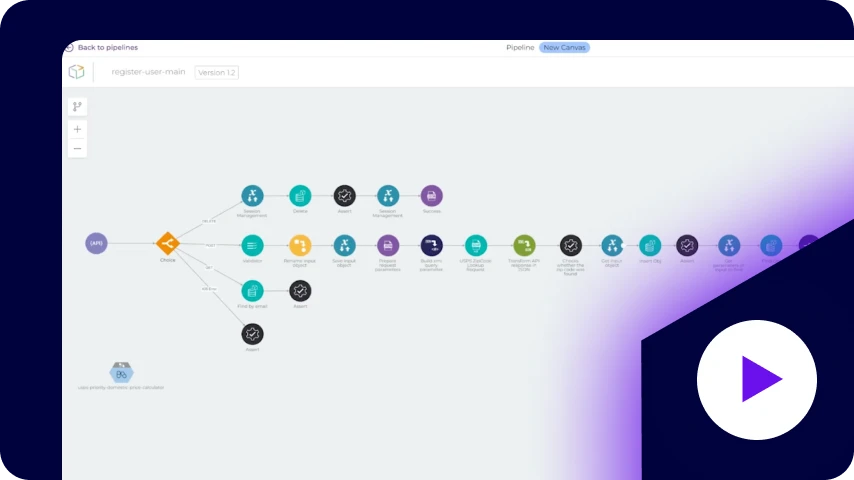
Saiba como a Digibee ajudou o Grupo Víssimo a integrar sua plataforma legada com uma plataforma de mercado em tempo recorde com excelente suporte.
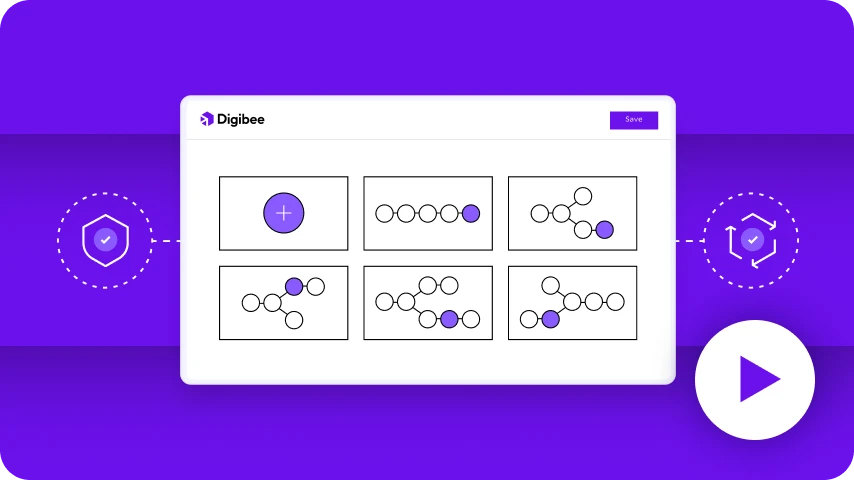
Saiba como a solução de integração perfeita da Digibee para GoPro transformou sua workflows.

Os sistemas legados são realmente o fim do mundo? Para muitas empresas, eles são tecnologias essenciais para manter as operações em funcionamento e a receita fluindo. Mas, com tanta crítica negativa, você pode até pensar que eles representam o fim dos negócios como os conhecemos.
E eles são o fim do mundo mesmo? Não necessariamente. Podem ser? Com certeza.
Mas, para entender completamente o que são sistemas legados e por que todos estão preocupados com eles, precisamos nos aprofundar um pouco mais. Neste post, vamos definir o que é um sistema legado, apresentar alguns exemplos e examinar o valor, os riscos e os desafios associados a esses sistemas.
Antes de discutirmos os riscos e desafios de um sistema legado, precisamos esclarecer sobre o que estamos falando. É surpreendentemente difícil encontrar uma definição amplamente aceita de sistemas legados – o que pode tornar desafiador identificar se isso é um problema na sua organização.

>> Agende uma demonstração personalizada com nossa equipe de especialistas e veja como o iPaaS da Digibee trará eficiência ao seu negócio.
Sistemas legados incluem sistemas computacionais, linguagens de programação, aplicativos, processos ou hardware que são:
Dica de especialista: Não caia na armadilha de pensar que um sistema ou ferramenta não é “legado” só porque tem apenas alguns anos. Qualquer tecnologia que se enquadre nos critérios acima é considerada um sistema legado.
Sistemas legados estão em toda parte. Qualquer empresa que existia antes do surgimento das companhias totalmente digitais teve que — ou terá que — atualizar seus sistemas antigos, caso queira competir no espaço digital atual. Infraestrutura envelhecida e tecnologia obsoleta vêm em diferentes formas e tamanhos, mas aqui estão quatro exemplos mais conhecidos de tecnologia legada:
A Microsoft anunciou o fim da vida útil de seus servidores SharePoint de 2013, 2016 e 2019, com desligamento final em julho de 2026. Pesquisas indicam que uma porcentagem significativa de organizações dos setores financeiro, governamental, de saúde e manufatura na América do Norte ainda utiliza essa ferramenta — e muitos não têm planos de migrar para outra solução.
Antes considerado inovador, o SharePoint on-premises tornou-se difícil (e caro) de personalizar. Ele não escala bem e carece de muitas capacidades de relatório e supervisão que atualmente são consideradas padrão.
Se você está ligado ao setor financeiro, provavelmente tem ouvido discussões sobre COBOL há pelo menos uma década. Essa linguagem de programação existe há mais de 60 anos e impulsiona bilhões de transações em caixas eletrônicos e cartões de crédito anualmente..
A idade do COBOL não é o problema. Desenvolvedores qualificados já estão em faltae aqueles com a expertise para traduzir código COBOL para linguagens modernas amplamente utilizadas são ainda mais escassos. Mesmo desenvolvedores experientes podem encontrar dificuldades para traduzir COBOL devido à maneira pouco convencional com que a linguagem usa alguns comandos padrão de programação.
Assim como o SharePoint, a SAP anunciou planos de encerrar o suporte para seu ERP on-premise em 2027. O modelo atual exige que empresas que ainda o utilizam façam altos investimentos no desenvolvimento e na manutenção de códigos personalizados para adaptá-lo aos processos de negócios atuais.
91% dos usuários de SAP afirmam depender de código customizado, e 90% do código em uso é considerado entre “importante” e “extremamente essencial”.Os custos para continuar usando a ferramenta já são altos e tendem a aumentar conforme novas tecnologias e tendências surgem.
Houve uma época em que 43% dos smartphones nos EUA eram Blackberries. Embora a queda da marca tenha sido rápida ao não conseguir se adaptar às mudanças nas expectativas dos consumidores, impulsionadas por novos modelos da Apple e Samsung, a empresa só anunciou oficialmente o fim do suporte para seu sistema operacional em janeiro de 2022.
As limitações do hardware da Blackberry e a recusa da empresa em adotar ferramentas desejadas pelos clientes – como a preferência por teclado em vez de tela sensível ao toque – custaram à empresa sua participação de mercado e, no fim das contas, tornaram obsoletos os celulares que um dia foram icônicos.
A necessidade de substituir sistemas desatualizados, difíceis de manter e ineficientes pode parecer óbvia. Então, por que as empresas resistem à integração de sistemas legados e continuam a utilizar plataformas e ferramentas como as mencionadas anteriormente?
Há vários motivos:
Esse é um argumento comum entre executivos que resistem à transformação digital em favor das ferramentas que já conhecem e em que confiam. Pode ser difícil reconhecer (ou justificar) a necessidade de reformular sistemas importantes quando a solução existente – com a qual os funcionários já estão acostumados – parece dar conta do recado.
Equilibrar receita e custos é sempre uma preocupação. O custo para atualizar, ou pior, substituir tecnologias essenciais para o negócio é muitas vezes alto. Em muitos casos, as empresas já investiram substancialmente nos sistemas existentes, então lidar com um aumento lento nos custos de manutenção pode parecer preferível a descartar tudo e começar do zero.
Sistemas legados costumam desempenhar um papel vital nas operações do dia a dia. Por isso, a ideia de mudar para uma nova solução (cuja confiabilidade ainda é desconhecida) pode ser assustadora. Se continuar com a tecnologia antiga pode causar problemas no futuro, muitas empresas preferem correr o risco, em vez de comprometer a continuidade operacional com uma grande mudança.
“Substituir aplicativos e sistemas legados por sistemas baseados em novas e diferentes tecnologias é um dos maiores desafios dos profissionais de sistemas de informação (SI). À medida que as empresas atualizam ou alteram suas tecnologias, elas devem garantir a compatibilidade com os sistemas antigos e os formatos de dados que ainda estão em uso.”
Gartner
As preocupações sobre a transição para fora dos sistemas legados não são infundadas, mas os riscos de continuar com uma arquitetura desatualizada – por mais “testada e comprovada” que seja – também não são desprezíveis.
As empresas que continuam a depender da tecnologia legada enfrentarão problemas relacionados a:
O custo de manter sistemas desatualizados só aumentará com o tempo, à medida que o suporte for descontinuado e houver menos especialistas de TI com as habilidades necessárias para manter os sistemas legados funcionando – e conectados a ferramentas mais modernas.
A velocidade com que a tecnologia evolui está aumentando exponencialmente. Sistemas legados que não falham completamente ainda não conseguirão acompanhar os padrões em constante ascensão e as rápidas mudanças nas tendências de mercado e nas demandas dos consumidores.
A pandemia apenas acelerou uma mudança já existente para a realização de negócios online, e a dependência de sistemas legados pode prejudicar os esforços de transformação digital e tornar a adoção de novas soluções mais desafiadora.
A dependência de plataformas envelhecidas ou desatualizadas pode afetar negativamente a experiência oferecida aos seus clientes. E a lealdade à marca construída só pode levar você até certo ponto, quando não é possível atender às expectativas.
A inovadora plataforma de integração empresarial low-code da Digibee elimina os obstáculos que os sistemas legados impõem ao crescimento e ao sucesso da sua empresa.
Nossas integrações reutilizáveis permitem que até desenvolvedores juniores conectem sistemas legados a novas tecnologias e ferramentas, modernizando sua arquitetura e acelerando a transformação digital sem tempo de inatividade ou interrupção nas suas operações. Agende uma demonstração personalizada e descubra o diferencial Digibee por si mesmo hoje.

Entrevista com o líder de engenharia Chris Cortese para discutir tópicos como migração de legado, transformação digital, envolvimento do cliente e lições aprendidas.
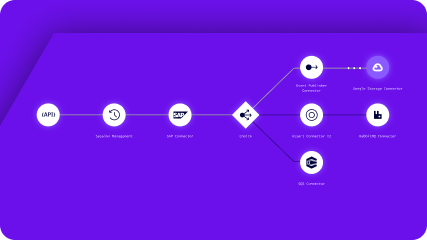
Problemas Complexos = Soluções Complexas
Tentar definir todos os seus casos de uso de integração empresarial é um trabalho intenso, e mapear todas as plataformas que precisam ser conectadas não é muito mais fácil — nós entendemos. Para garantir que a integração em si não aumente a complexidade enfrentada pela sua equipe, trabalhamos duro para criar a plataforma de integração mais elegante e simples possível (sem abrir mão da capacidade de lidar com problemas difíceis ou únicos, prometemos).
Na Digibee, adotamos uma abordagem de ciclo completo para guiar sua equipe nas etapas de Construção, Execução e Monitoramento das suas integrações de forma intuitiva, ajudando você a “conectar os pontos” e ter uma visão geral de como suas integrações estão funcionando em quase tempo real. Também entendemos que cada empresa tem sua própria estrutura, então a versatilidade é uma característica essencial incorporada em cada etapa da nossa plataforma de integração.
Neste blog post, oferecemos um tour guiado pela interface Build, Run, Monitor da Digibee para ajudá-lo a visualizar como nosso iPaaS empresarial único pode atender às suas necessidades — seja qual for a estrutura da sua empresa, os requisitos de integração ou a etapa do ciclo de vida da integração em que você esteja.
>> Agende uma demonstração personalizada com nossa equipe de especialistas e veja como o iPaaS da Digibee trará eficiência ao seu negócio.
Nossa plataforma de construção é onde tudo começa. Seja para os desenvolvedores criarem uma nova integração ou atualizarem uma já existente, esta etapa mantém todas as integrações organizadas e fáceis de localizar. É aqui também que você pode definir exatamente quem deve ter acesso a cada área da plataforma Digibee, usando nossa estrutura flexível de realms, que garante que cada usuário veja apenas o que é relevante para ele.
Dentro do realm de um usuário, mantemos os pipelines organizados sob seus respectivos projetos, facilitando a visualização de onde cada integração é utilizada no seu negócio. Nosso canvas intuitivo de arrastar e soltar, combinado com as cápsulas Digibee — que encapsulam lógicas de negócios pré-configuradas e poderosas — elimina a complexidade da criação de integrações, mas mantém a sofisticação necessária.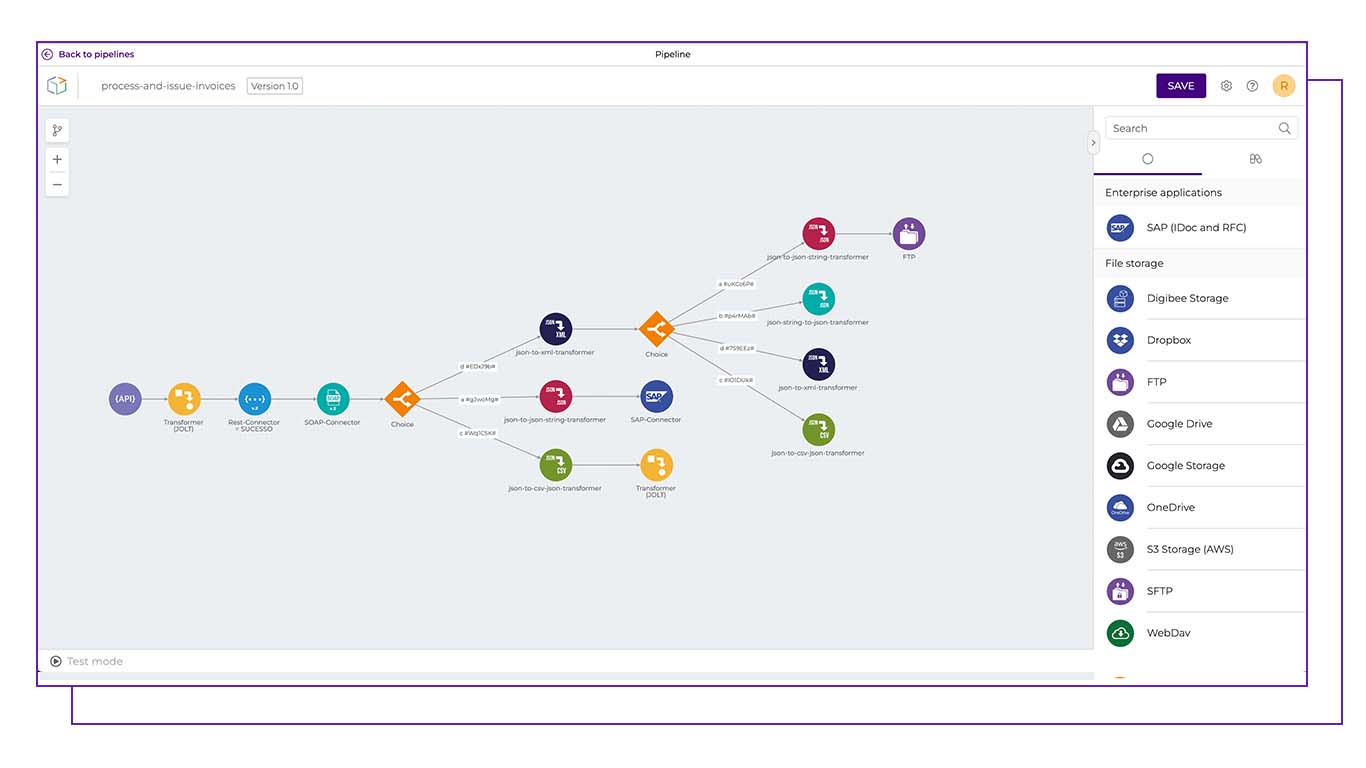 Criar um novo pipeline com a plataforma de integração low-code da Digibee é fácil para os desenvolvedores dominarem. Para garantir que o processo de aprendizado seja tranquilo, nossa assinatura Platform-as-a-Service inclui suporte completo – trabalhamos lado a lado com sua equipe na construção desses pipelines até que estejam prontos para seguir sozinhos.
Criar um novo pipeline com a plataforma de integração low-code da Digibee é fácil para os desenvolvedores dominarem. Para garantir que o processo de aprendizado seja tranquilo, nossa assinatura Platform-as-a-Service inclui suporte completo – trabalhamos lado a lado com sua equipe na construção desses pipelines até que estejam prontos para seguir sozinhos.
Nossa plataforma de construção em ação:
Nosso trabalho com a varejista internacional de calçados Payless é um ótimo exemplo do que nossa plataforma de construção pode realizar. Embora nossa plataforma de integração empresarial pareça simples, ela pode ser escalada rapidamente para enfrentar os maiores desafios de integração.
Para a Payless, a Digibee entregou integrações para uma nova plataforma de e-commerce, conectando mais de 200 lojas em 15 países. Com a eficiência de nossa interface low-code de arrastar e soltar, desenvolvemos as soluções de integração em menos de 30 dias!
Para ajudar sua equipe a gerenciar as integrações daqui para frente (sem querer fugir delas), tornamos o processo de implantação de uma integração tão simples quanto tomar estas 3 decisões rápidas antes de clicar em ‘Implantar’:
Se, mais tarde, sua equipe perceber que precisa ajustar o tamanho, a concorrência ou o nível de paralelismo de um pipeline de integração, basta acessar o pipeline e atualizar as configurações a qualquer momento!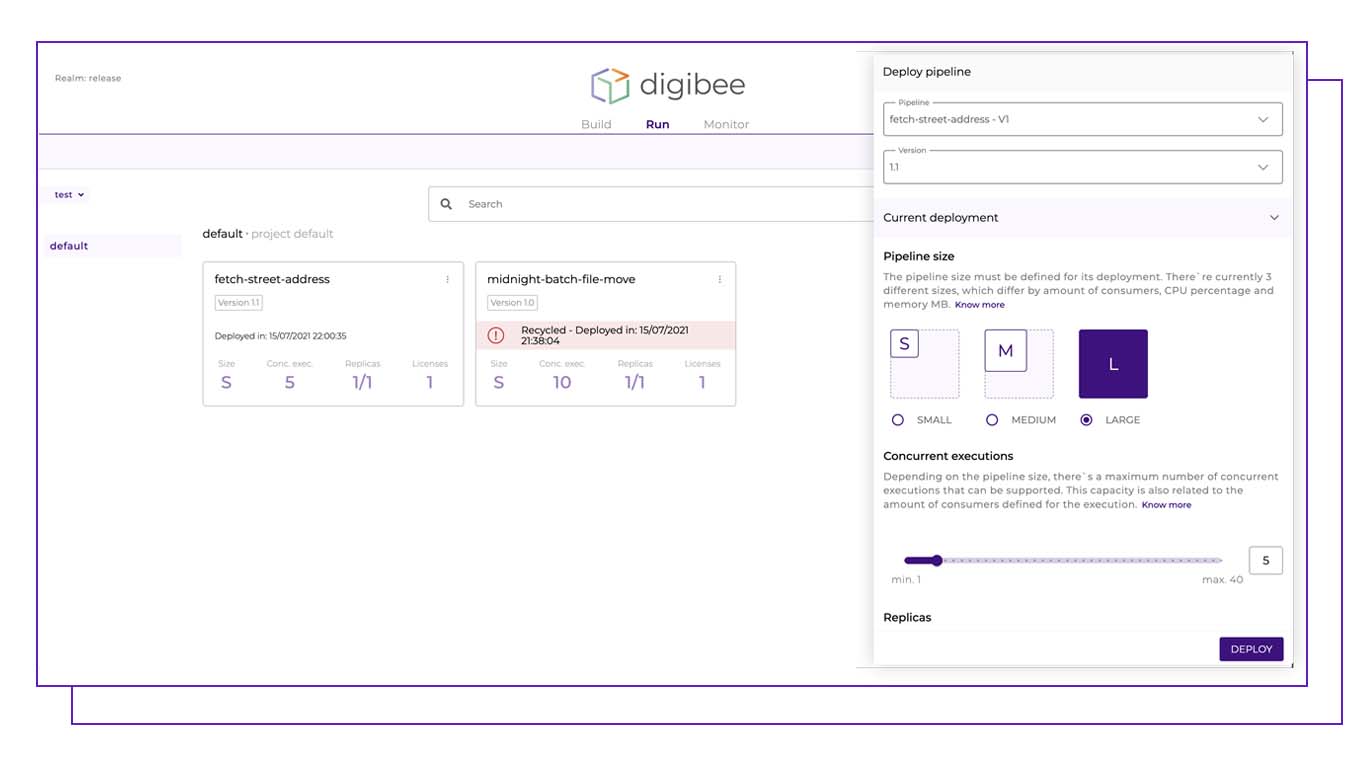 Assim como nossa plataforma Build, a UX da plataforma Run mantém tudo visualmente organizado e fácil de entender. Todos os pipelines ou projetos aos quais um usuário tem acesso aparecem no seu realm, organizados por projetos. Com apenas um olhar, é possível visualizar estatísticas importantes de cada pipeline, como a data de implantação, o número da versão e a quantidade de réplicas.
Assim como nossa plataforma Build, a UX da plataforma Run mantém tudo visualmente organizado e fácil de entender. Todos os pipelines ou projetos aos quais um usuário tem acesso aparecem no seu realm, organizados por projetos. Com apenas um olhar, é possível visualizar estatísticas importantes de cada pipeline, como a data de implantação, o número da versão e a quantidade de réplicas.
Nosso ambiente de runtime é totalmente conteinerizado – isso significa que suas integrações não compartilham poder de processamento ou velocidade com mais ninguém, garantindo desempenho consistente mesmo nos períodos de maior demanda.
Nosso processo de execução em ação:
Bauducco, maior fabricante de produtos de panificação do Brasil, escolheu a Digibee para resolver os desafios enfrentados na migração de seu sistema legado para o SAP S/4HANA. Com 5 unidades de produção, 12 filiais e 7 centros de distribuição estratégicos, havia muitos processos em movimento para gerenciar. Combinado com diversos processos manuais, o sistema legado era difícil de operar e suscetível a erros.
A Digibee desenvolveu uma plataforma iPaaS corporativa que integrou efetivamente o sistema legado da Bauduccoao SAP S/4HANA, enquanto simplificava o ambiente SAP existente. Isso resultou em maior estabilidade no ambiente e reduziu o tempo e o custo projetados para o projeto de integração em mais de 30%, tudo isso sem nenhum tempo de inatividade.
Depois que uma plataforma de integração está construída e em execução, a qualidade dos insights obtidos por meio do monitoramento pode se tornar uma das ferramentas mais impactantes para aprender a se adaptar e crescer. Com isso em mente, projetamos uma plataforma de monitoramento intuitiva e poderosa para complementar nossas funcionalidades Build e Run.
Na aba Monitor, sua equipe pode visualizar facilmente como todas as suas integrações estão desempenhando, tanto em tempo real quanto em análises históricas. As métricas de desempenho e a exibição visual tornam simples a detecção de problemas ou áreas que podem ser otimizadas. Além disso, tornamos o gerenciamento de erros mais eficiente, permitindo que eventos sejam enviados diretamente para soluções corporativas de ticketing e monitoramento, facilitando a resolução de incidentes.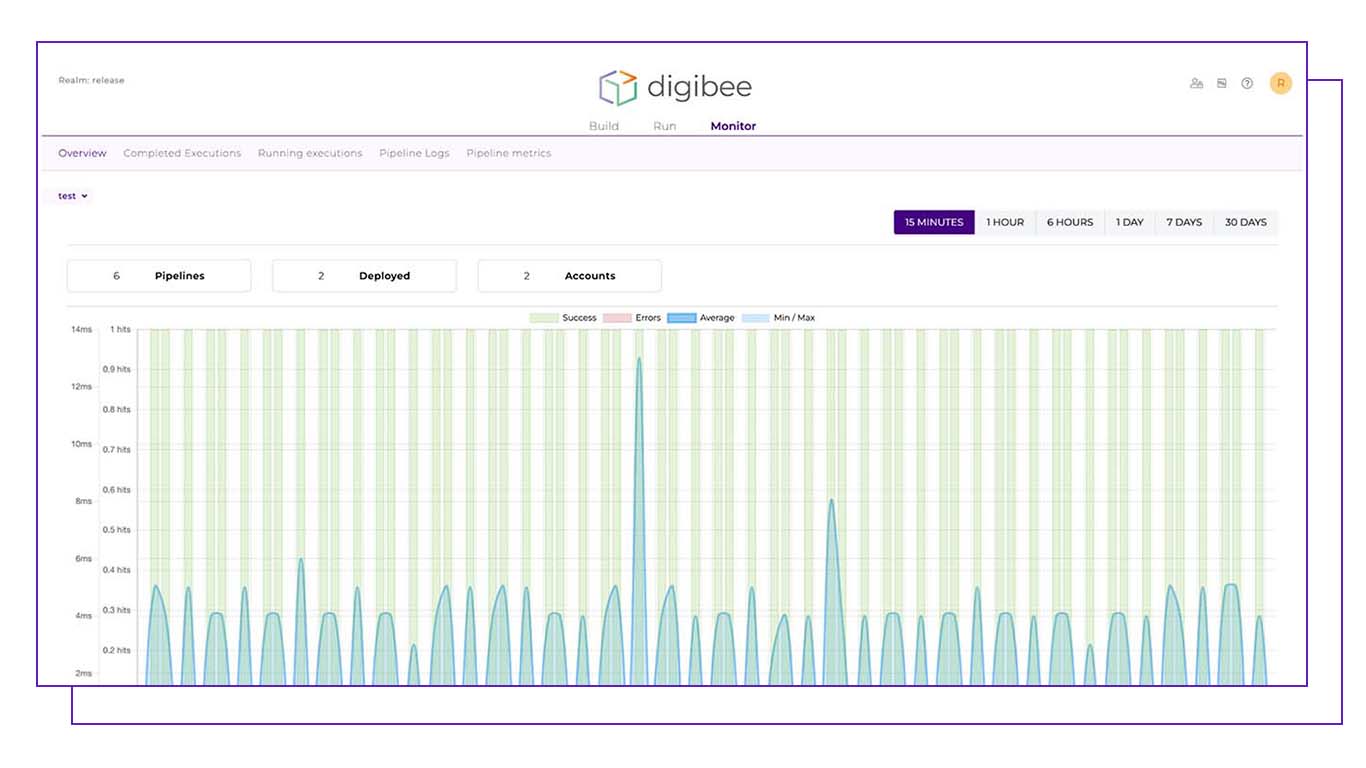
Nossas ferramentas de monitoramento em ação:
A Digibee fez parceria com a Weir Group, líder global em tecnologia de mineração, para criar uma integração flexível que suportasse workflows essenciais. O trabalho exigiu a integração de vários sistemas corporativos globais com sistemas locais, facilitando o fluxo contínuo e bidirecional de informações por meio da plataforma de integração.
Um dos sistemas integrados foi o MES (Sistema de Execução de Manufatura), responsável por fornecer dados e insights em tempo real sobre o processo de fabricação de produtos. Para garantir que a empresa não perdesse nenhuma dessas informações cruciais do MES, a Digibee implementou alertas em quase tempo real dentro da plataforma de integração corporativa, sinalizando possíveis problemas no fluxo de integração antes que qualquer interrupção ocorresse.
Para saber mais sobre nossas soluções de integração empresarial intuitivas Build-Run-Monitor e como nossa UX adaptável capacita sua equipe em todas as fases da jornada de integração, aceite o Desafio Digibee:
Dê-nos o projeto de integração que você não consegue resolver até o próximo ano, mas precisa para o próximo trimestre – e mostraremos a diferença Digibee até a próxima semana.

A experiência do cliente é a chave para desbloquear lucros no setor varejista. Embora manter os consumidores satisfeitos com sua marca sempre tenha sido uma prioridade para organizações de varejo, sua importância atingiu níveis sem precedentes.
À medida que as incertezas econômicas persistem ao redor do mundo, a capacidade de oferecer a experiência ideal que os consumidores esperam em troca de sua fidelidade tornou-se uma questão de sobrevivência para muitas empresas. Então, como otimizar a experiência do cliente – e qual é o papel da TI no varejo?

>> Agende uma demonstração personalizada com nossa equipe de especialistas e veja como o iPaaS da Digibee trará eficiência ao seu negócio.
A tecnologia é, ao mesmo tempo, o ativo mais poderoso e o maior desafio dos varejistas. Marcas estabelecidas enfrentam uma nova concorrência de nativos digitais que estão transformando os modelos de negócios tradicionais com opções diretas ao consumidor. Os avanços tecnológicos em diversos aspectos da vida dos consumidores levaram a uma demanda por serviços personalizados, respostas rápidas e experiências adaptadas às necessidades e interesses individuais.
2022 foi um ano de transformação digital para muitas marcas de varejo, e 2023 promete seguir o mesmo caminho , com as empresas adotando:
A tecnologia digital e o varejo tornaram-se inseparáveis. As marcas precisam adotar ferramentas que aumentem a eficiência e a personalização para encontrar os clientes onde eles estão – ou se resignar à obsolescência.
A lista de tendências e avanços em tecnologia no varejo pode parecer intimidadora. Se a sua marca ainda está lutando para equilibrar o atendimento presencial com o comércio eletrônico e compras sociais, como será possível aproveitar a realidade virtual ou o metaverso?
Uma etapa de cada vez, é assim que se faz. Independentemente de onde sua marca está atualmente no espectro entre o varejo físico tradicional e o totalmente virtual, aqui estão três etapas-chave para ajudá-lo a oferecer a experiência de varejo que seus clientes exigem.
Identifique onde e como a arquitetura de TI está impedindo sua capacidade de aproveitar novas ferramentas e tendências. Seus dados ainda estão presos em silos que impedem as equipes físicas de entender como os consumidores interagem online? Esse é um obstáculo significativo que precisa ser superado. Garantir que todos os seus sistemas estejam conectados e se comunicando – a migração para ferramentas e aplicações baseadas em nuvem pode apoiar isso – tem um impacto significativo na experiência do cliente que você entrega.
|
A GJP Hotels & Resorts percebeu que havia um problema quando as reclamações dos clientes sobre o longo processo de check-in aumentaram. A experiência negativa estava ameaçando o futuro da empresa – e eles tomaram uma ação. A empresa utilizou a plataforma da Digibee para integrar suas ferramentas e sistemas de gestão de propriedades existentes com portais digitais de autoatendimento, o que reduziu o tempo de espera dos clientes em 80% e as reclamações em 100% no primeiro ano de implantação. |
Talvez você já tenha começado a acessar novas soluções de TI para o varejo. Mas as novas ferramentas frequentemente vêm com requisitos adicionais de implantação e manutenção. Você depende de um fornecedor externo para ajudá-lo a acompanhar os nativos digitais? Ou a corrida para combinar tecnologia digital e varejo está colocando uma carga adicional sobre a sua já sobrecarregada equipe de desenvolvimento?
Em TI, a escassez de talentos , que se desenvolveu após a pandemia, provavelmente vai persistir, portanto, uma parte crucial da otimização da experiência do cliente (CX) é garantir que sua organização consiga acompanhar as novas tendências e mudanças no mercado.
Há uma razão pela qual o princípio K.I.S.S. (Keep It Simple, Stupid) é tão onipresente. A mudança para uma solução de comércio totalmente integrada não precisa ser complexa ou cara. Ferramentas e plataformas low-code ou sem código facilitam a criação e implantação das aplicações e integrações necessárias para manter os sistemas conectados e os clientes satisfeitos.
|
A Payless reconheceu a necessidade de integrar seus ecommerces e lojas físicas para oferecer uma experiência consistente ao cliente, mas enfrentou desafios com as exigências legais e fiscais discrepantes nos 15 países onde tinha lojas. Eles buscaram a Digibee por uma solução de integração segura, confiável e capaz de escalar para acomodar os picos de vendas sazonais. A Digibee entregou uma solução de ecommerce completamente segura, abrangendo 200 lojas em 15 países em menos de 30 dias. |
A iPaaS corporativa da Digibee é uma solução de integração de baixo código para o ciclo completo, que permite que as marcas adotem as soluções de TI para o varejo necessárias para competir. Independentemente do nível de maturidade de TI atual da sua organização, podemos ajudá-lo a modernizar soluções legadas e integrar sistemas para aproveitar todas as ferramentas digitais mais recentes.
Baixe uma cópia gratuita de Fully Integrated Commerce for the Modern Retailer para saber como a iPaaS corporativa da Digibee pode melhorar a experiência do cliente no varejo, tanto online quanto presencial, ou agende uma demonstração personalizada para ver nossa solução em ação.

Em um contrato recente com a Forrester Consulting, pedimos aos especialistas que colocassem números concretos por trás do valor que a Digibee oferece aos nossos clientes. O resultado? O relatório Total Economic Impact™ Of Digibee’s Integration Platform as a Service (eiPaaS)1, um exame detalhado que quantifica o lado positivo da tecnologia eiPaaS da Digibee.
Para contextualizar a pesquisa, a Forrester realizou entrevistas com clientes Digibee existentes, pegando o que eles aprenderam e usando para criar um cliente composto: uma organização de serviços financeiros que chamaremos de FinCo. Esta postagem de blog explora em detalhes o impacto econômico total proporcionado à FinCo após a implementação do Digibee.

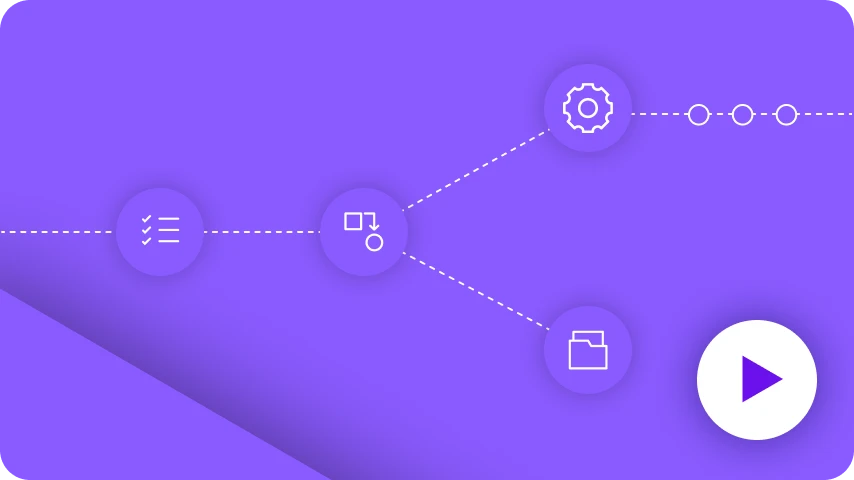
Os especialistas do setor exploram os desafios e as oportunidades da integração do varejo, destacando os principais componentes que os varejistas precisam para ter sucesso em 2023.
X